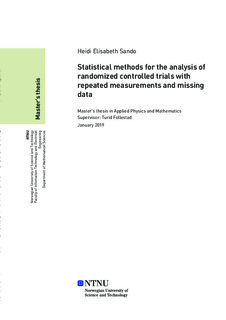| dc.contributor.advisor | Follestad, Turid | |
| dc.contributor.advisor | Langaas, Mette | |
| dc.contributor.author | Sando, Heidi Elisabeth | |
| dc.date.accessioned | 2019-10-15T14:00:32Z | |
| dc.date.available | 2019-10-15T14:00:32Z | |
| dc.date.issued | 2019 | |
| dc.identifier.uri | http://hdl.handle.net/11250/2622330 | |
| dc.description.abstract | Randomiserte kontrollerte forsøk (RCT) er en mye brukt metode i medisinsk forskning. Målet med metoden er å analysere effekten av en behandling over tid. Denne typen forsøk er utsatt for manglende data. Formålet med denne rapporten er å sammenligne ulike metoder for å analysere langsgående RCT med ulike antagelser om de manglende dataene.
Metodene som brukes til å analysere RCT er: Sammenligning av snitt på oppfølgningstidspunkt, analyse av endring i forskjell, analyse av kovarians (ANCOVA) og begrenset langsgående data analyse (cLDA). Årsaken til hvorfor data mangler er en av hovedutfordringene knyttet til manglende data. Dette kalles den manglende datamekanismen. De forskjellige manglende data mekanismene er: Mangler helt tilfeldig (MCAR), mangler tilfeldig (MAR) og mangler ikke tilfeldig (MNAR).
Prosentdelen av manglende data er også viktig når du analyserer manglende data.
Ulike scenarier av manglende data i langsgående forsøk er simulert for å sammenligne metodene som kan brukes til å analysere RCT sammen med forskjellige metoder for å håndtere manglende data. Metodene sammenlignes med hensyn til bias, styrke og dekning av konfidensintervall. Metodene til cLDA og ANCOVA er også brukt på et klinisk forsøk.
Metodene sammenligning av snitt på oppfølgningstidspunkt og analyse av endring i forskjell
er oftest brukt på RCT med kun to tidspunkter. Resultatene av metoden sammenligning av snitt på oppfølgningstidspunkt avhenger veldig av korrelasjonen mellom tidspunktene, mens metoden for analyse av endring i forskjell tar ikke hensyn til korrelasjonen eller baselineverdiene. Med lav korrelasjon er metoden for analyse av endring i forskjell like god som metodene ANCOVA og cLDA, og overlegen sammenlignet med metoden for analyse av endring i forskjell. Med høy korrelasjon er metoden for analyse av endring i forskjell like god som metodene ANCOVA og cLDA, og overlegen til metoden for analyse av endring i forskjell.
Generelt er metodene for ANCOVA og cLDA overlegne sammenlignet med de andre metodene. Uten manglende data produserer begge metodene like gode resultater. Når det mangler data, brukes mer informasjon i analysen ved å bruke cLDA sammenlignet med ANCOVA. cLDA kan derfor betraktes som den foretrukne metoden sammenlignet med ANCOVA, men når multippel imputasjon brukes sammen med ANCOVA er resultatene sammenlignbare med resultatene fra cLDA. De manglende datamekanismene MAR og MCAR kan produsere feilfrie estimater ved bruk av metodene ANCOVA og cLDA, men styrken reduseres når det mangler data. Effekten av metodene reduseres også når prosentandelen av manglende data øker. I tillegg, når prosentandelen av manglende data når 20%, kan det være bias i resultatene, uansett valg av metode. | |
| dc.description.abstract | Randomized controlled trials (RCTs) is a widely used method in medical research. The method aims to analyze the effect of a treatment over time. This type of research is exposed to missing data. The aim of this report is to compare different methods to analyze longitudinal RCTs with different assumptions about the missing data.
The methods used to analyze RCTs are: Comparisons of follow-up scores, change score analysis, analysis of covariance (ANCOVA) and constrained longitudinal analysis (cLDA).
The reason for why data are missing is one of the main challenges associated with missing data. This is called the missing data mechanism. The different missing data mechanisms are: Missing completely at random (MCAR), missing at random (MAR) and missing not at random (MNAR). The percentage of missing data is also of importance when analyzing missing data.
Different scenarios of missing data in longitudinal trials are simulated to compare the methods used to analyze RCTs together with different methods to handle missing data. The methods are compared with respect to bias, power and confidence interval coverage.
The methods of cLDA and ANCOVA are also applied on a real clinical trial.
The methods of comparisons of follow-up score and change score analysis are most commonly used on RCTs with only two time points. The results of the method of change score depends highly on the correlation between the time points, while the method of follow-up does not take the correlation or the baseline values into account. With low correlation the method of follow-up is just as good as the method of ANCOVA and cLDA, and superior to the method of change score. With high correlation the method of change score analysis is equally good as the method of ANCOVA and cLDA, and superior to the method of follow-up. In general the methods of ANCOVA and cLDA are superior to the other methods. With no missing data produces the methods equally good results. When there are missing data more information is used in the analysis using the method of cLDA compared to the method of ANCOVA. Thus, the method of cLDA may be regarded as the method of choice compared to the method of ANCOVA.However, when multiple imputation is used together with the method of ANCOVA are the results comparable to the method of cLDA. The missing data mechanisms MAR and MCAR can produce unbiased estimates when using the methods of ANCOVA and cLDA, but the power decreases when there are missing data. The power of the methods also decreases when the percentage of missing data increases. In addition, when the percentage of missing data reaches 20%, the results may be biased, regardless the choice of method. | |
| dc.language | eng | |
| dc.publisher | NTNU | |
| dc.title | Statistical methods for the analysis of randomized controlled trials with repeated measurements and missing data | |
| dc.type | Master thesis | |
